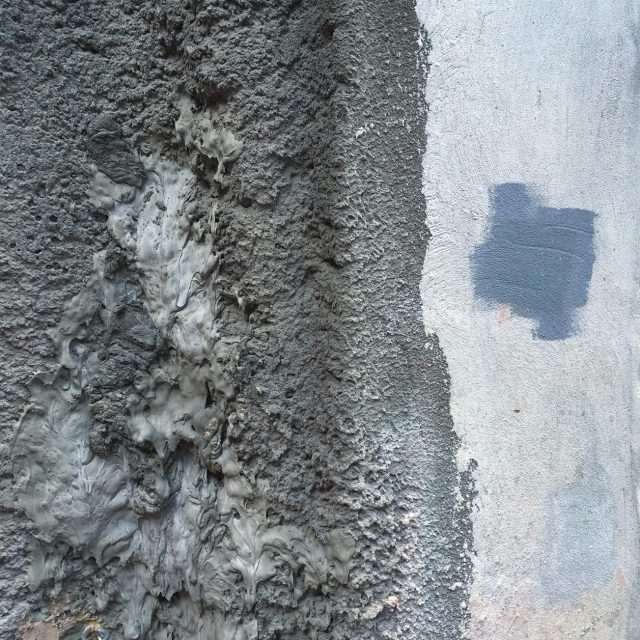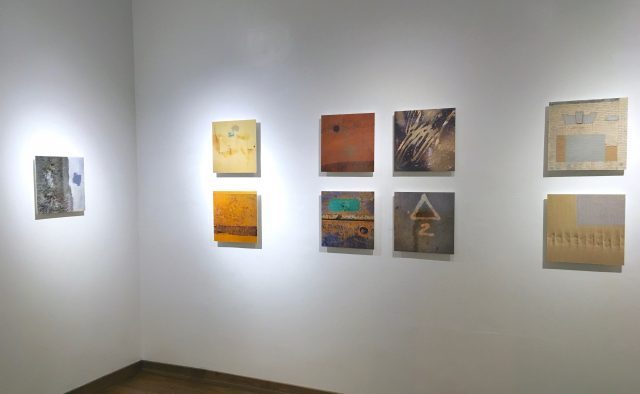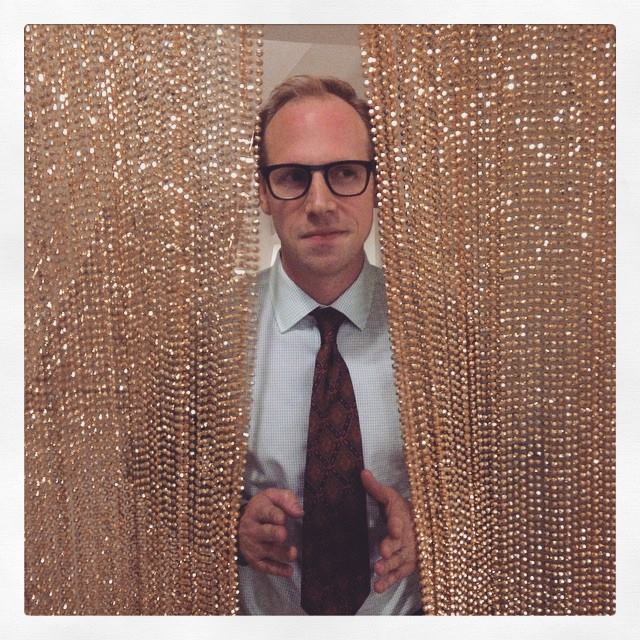
Grady Gerbracht, “#incidentalart No. 08,” #incidentalart #found #painting #composition #abstract #texture #color #marks #Nola #alley #neworleans #street #photography #poons #buffed #swastika (photo © 2016 by Grady Gerbracht)
#incidentalart
Senaspace Art & Tattoo
229 Centre St.
Tuesday – Sunday through November 6, free, 12 noon – 8:00 pm
212-966-5151
www.senaspace.com
www.gradygerbracht.info
For the past twenty years, New York native Grady Gerbracht has been making the most of his daily commute, taking photographs of unique elements he finds on city streets and walls, what he refers to as “incidental” works of art. He can be moved by rust, an unusual splotch of color, a piece of tape, stains, cigarettes in mud, and unusual surface textures. He posts the photographs on Instagram and Facebook, numbering each one and identifying them with pertinent information as well as adding his own interpretation; for example, “#incidentalart No. 18” is described as “#incidentalart #wrap #sculpture #architecture #christo #jeanclaude #form #stretch #storefrontforartandarchitecture,” while “#incidentalart No. 26” features the labels “#incidentalart #found #painting #composition #color #texture #patina #pattern #duct tape #grid #surface #marks #abstract.” As he notes in his hashtags, various pieces are reminiscent of the work of Mark Rothko, Christo and Jeanne-Claude, and Larry Poons.
A teacher, curator, “sonic sculptor,” and “spontaneous composer,” Gerbracht, who lives in Brooklyn with his wife and their two children, has previously created such projects as “viaDUCT,” “Commutes: NJ Transit Series,” and “Site & Sound,” involving photography, sound, performance, and intervention in relation to architectural space. He’s had solo exhibitions and been in group shows at Sculpture Center, Smack Mellon, the International Festival of Performance Art in Toronto, the Queens Museum, the Drawing Center, the National Museum of Contemporary Art in Helsinki, and the Anarchist Art Fair. His current solo exhibit, “#incidentalart,” consisting of twenty-six of his #incidentalart photographs, continues at Senaspace through November 6.
twi-ny: You’ve been taking these “incidental” pictures for twenty years. What got you started?
Grady Gerbracht: I have been doing this for a long time, so it’s hard to say when it began. There was not a landmark event or aha! moment which started it all. It was more of a gradual evolution of personal formal style in confluence with certain conceptual concerns. I think every artist has a particular aesthetic sensibility which is unique to them. Each of us is compelled to make certain kinds of marks or forms, or make certain kinds of pictures, which is how we can tell one artist’s hand from another. I am sure that my openness to aesthetic sensibilities that are not my own has been influenced by a lifetime of learning and teaching about art. To teach, one has to be familiar with art history in all its variety. One also has to be able to get inside the mind of other artists during critiques and studio visits in order to provide constructive criticism. Chance operations (as per John Cage and others) are of interest to me as well. It seems that all of these elements add up to my interest in finding and calling attention to things that look like art in my everyday surroundings.

Installation shot of Grady Gerbracht’s “#incidentalart” show at Senaspace features select groupings (photo © 2016 by Grady Gerbracht)
twi-ny: Why did you decide to call the series “incidental”?
GG: I chose the term Incidental Art because it is the best way I can explain my interests. There are other terms being used to describe similar ideas, such as involuntary painting and found objects. I find this nomenclature too limiting. Though I deliberately selected the works in this show to be based on ideas of two-dimensional painting for the sake of simplicity, my concept of Incidental Art is broader than that. The next exhibition could easily be images of things that look like sculptures, or of found situations that look like performance art or happenings.
twi-ny: The photos in the show were mostly taken in New York City, with a few from Chicago as well. Have you documented other cities in your travels, or is there something unique about the streets in these two metropolises?
GG: Another conceptual strand that runs through my work is the idea of turning the “wasted time” of my daily commute into productive studio time by actively making art during my travels between home and day job workplace. I made a commitment to do just that years ago when I had a three-hour commute to my first teaching job and I noticed that I was spending more time commuting than I was actually teaching. I could explain this through Marxist critical theory (and I have in academic journals) but quite honestly, it is just a practical way to make the best use of my time and it allows me to express myself creatively while on the go. I live in Brooklyn and my office is in Manhattan, so the majority of the images are from these boroughs. Sometimes I travel for my work, so there are images from Chicago and New Orleans in this exhibition because I have traveled to those cities recently.
twi-ny: Photography has changed a lot since 1996. What kind of cameras have you used over the years? Has that had any impact on the photos you take?
GG: Technology has changed a lot. I have made photos that fit into the umbrella term of Incidental Art with everything from professional 35mm and medium-format film cameras and DSLRs to my iPhone. The current exhibition is called “#incidentalart” because all of the images were made with an iPhone and uploaded to @gradygerbracht on Instagram with the hashtag #incidentalart. All of the images were produced actual size for the maximum resolution possible on my phone — that is why they are 15″ square. I wanted to be honest about what they are.
twi-ny: You post your photos on Instagram as well as Facebook, which have become repositories for amateur and professional photographers. Do you think that helps or hinders the concept of photography as art?
GG: Because of my commitment to make work during my commutes, I had been using the tools at hand to facilitate my process. I was not taking it very seriously, so I had no problem using the iPhone and Instagram feed. The images became very popular among social media friends and acquaintances, and many times people would ask when I was going to exhibit these images “IRL.” I was not planning to do it, but eventually it became clear that there was a demand so I decided to go ahead and show them.
I could have used fractal software to blow them up larger and look more like “contemporary art,” but I wanted to acknowledge what they are and where they came from. I did not want to stray too far from the immediacy of this pocket-sized studio technology. I still make pictures with my high-resolution DSLR, but that is not what this exhibit is about. The gallery space is relatively small and the venue is not a slick, commercial Chelsea warehouse-sized space, so it seemed appropriate to produce the images at this size for many reasons. I come from a tradition of conceptual art and institutional critique, so I can’t show anything without some consideration of context. I always think about it when I show my work; in fact, many of my projects make direct references to the spaces they are shown in.

Multimedia artist and teacher Grady Gerbracht peeks through Felix Gonzalez-Torres’s “Untitled (Golden)” (photo by Kerry Gaertner Gerbracht)
twi-ny: Is there a kind of aha! moment when you come upon something that you want to photograph? Are you looking for something specific? For example, many of the photographs in the show share a visual theme of looking like textured paintings, with three-dimensional qualities.
GG: I shoot things I am attracted to, but I also try to shoot things that look like art that I would not make — some of the images in the current exhibition look like Rothko paintings and I like his work, but the one used on the invitation card [ed. note: see top of page] looks very much like a Larry Poons painting and I never really liked the overly worked gobs of paint in his work. The fact is that I saw it on the street while traveling for work in New Orleans and thought, Hey, that wall in the alley looks like a Poons painting, so I framed it that way and the rest is history. I have been doing this so long my kids have begun to stop me on the street and say things like, “Dad, do you want to take a picture of that?” when they see some kind of peeling paint or some rich texture. They know what kind of surfaces I am attracted to — mostly things that look like paintings.
twi-ny: You’ve helped install many art shows in a professional capacity; did that make it harder or easier to install your own work?
GG: It is never easy for the artist to install his or her own work. It helps to have others whose opinions you trust to help with editing and placement decisions. Physically it is just math, so that part is easy.
twi-ny: The mounted photographs are hanging in very specific groupings. What was the reasoning behind how you decided to group them?
GG: I was not planning on hanging them in groups, but when I laid them out in the gallery and started looking at them, considering which should go where, I noticed that certain ones complemented each other, so the final groupings evolved out of aesthetic resonance. I also wanted to show that they could be purchased in groups or in pairs because they are small and affordable works one could compose with them, like tiles.